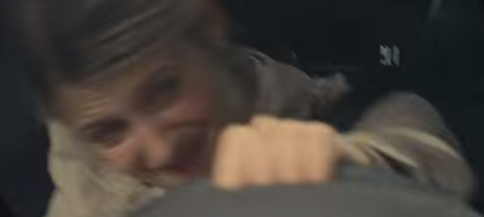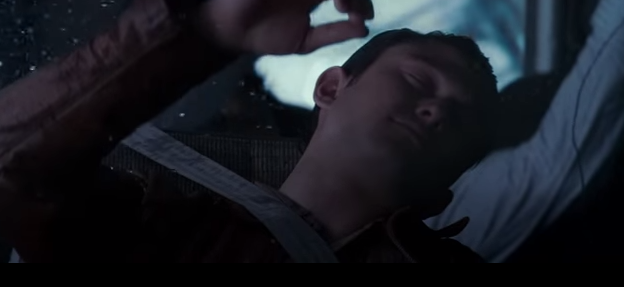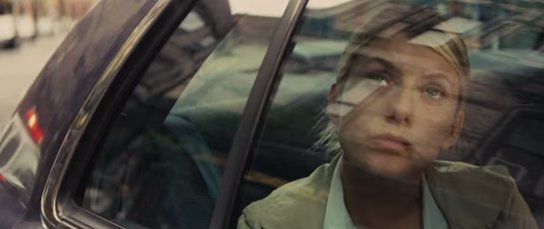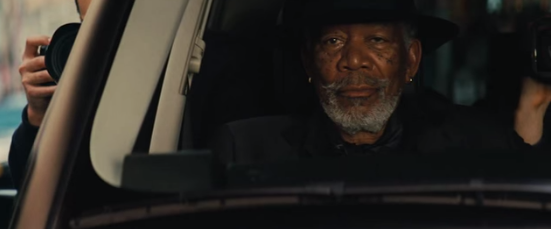My chosen clip is from the movie ‘Now You See Me’ and it is 5 minutes and 39 seconds long. This movie was released on May the 31st of 2013, and was filmed on 100% digital cameras. The story line for the movie is that four very gifted magicians - J. Daniel "Danny" Atlas, Merritt McKinney, Henley Reeves, and Jack Wilder - are brought together by an unknown benefactor and, one year later, are performing in Las Vegas as "The Four Horsemen," who are being sponsored by a man called Arthur Tressler.
For the finale of their first show, they declare they are going to be robbing a bank, and invite an audience member Étienne Forcier, who chooses the bake called Crédit Républicain de Paris. Forcier is apparently teleported to his bank in France, where he activates an air duct that vacuums up the money and showers it onto the Las Vegas crowd. Upon the discovery that the money really is missing from the bank vault, an FBI agent Dylan Rhodes is called to investigate the theft and is partnered with Interpol agent Alma Dray.
Combining shots into sequence
The Combining shots into their sequences is the process of putting all of the shots together and making them flow as one, only once all of the shots have been individually filmed. This movie has been filmed on all
digital cameras. If this movie had been filmed on film cameras I don’t believe
that there would be as many effects as what there are in the finished movie. Using
the digital camera to make the movie has helped to create it even more magical. If this movie has used splicing it will not
have been as successful as what it is now. I believe it would have taken a lot more
time to get the effects that the creators of the movie were hoping for.
Transitions
Transitions can be an instant start to the next scene or image changing. this can be done with a fade, fade to black, dissolve, pan from one person to another, or any other digital effect. This is when the joining of the clips is the transition from one to the other. For this scene that I have chosen there is not any dissolves, fades or wipes to get to each shot. However this clip has been filled with really quick cuts that enable the audience to keep up with all of the action that is happening. Each clip before the cut to the next clip is around 4-6 seconds long each. Having the transitions occurring so fast and so often is able to show the audience how fast this action or chase is going to be.
Visual
Continuity
At 5.12 there is an establishing shot. This is usually the first shot of a new scene, that is designed to show the audience where the action is going to be taking place, which is usually taken with a wide shot. In this clip here is showing the destruction that the action has now caused and helping the audience see the bigger picture to how fast and negative the chase had ended.
The Clip that I have chosen doesn’t show a 180 degree rule so I have found another one from a different clip. 180-degree rule is a guideline between a character and another character or object within a scene. The axis connects the characters, the first character is always frame right of the second character, who is then always frame left of the first and it then turns around the other way once the camera has crossed the axis. At 1.39 there is a 180 degree rule. This here shows the viewer what the characters are able to see when inside and outside of the room.
Video … https://www.youtube.com/watch?v=Ab5MA6PNN5s
At 1.20 there is a shot-reverse-shot. This technique is where the camera takes it in turns to face the characters who are currently talking, in this scene it is Dylan Rhodes and Alma Dray. It will change each time from starting over one characters shoulder looking at the other character facial expression while talking and to then swap it around. In this extract it helps to keep the audience to keep up to speed with who is talking and how there facial expressions are changing with each sentence that the character are saying to one another.
At 4.06 there is a match cuts on action. This technique is used by the editor who cuts parts of the film from one shot to another view that matches that first shots action. This helps carry the viewer along with the action with using a few shots in different views looking at the same action. In this extract it helps us to see the seriousness of the car crashing from two prospective.
At 5.01 there is some motivated editing with an eye line match-cut. This is where a cut between two shots where the first shot that are showing a person looking out of the frame and then on the second shot it is then showing what they were looking at. At this time in the clip there are three characters that are stood in front of a car looking forward out of the frame. The next shot at 5.05 is of a car upside down on the road that is burning in flames. This shot has made it appear that it is a point of view of one of the characters from the shot before, as they are watching from a distance as the car explodes.
Identification
The screen time is the amount of time that has been allocated to each actor while on screen. In this clip that I have chosen the most screen time in going towards the FBI agent Dylan Rhodes who is at the heart of the chase. This helps the audience to keep up with one of the detectives that are on the case showing how much work he is having to do, in order to be able to catch Jack Wilder
A close up is where a photograph or film image taken are at a close range and showing the subject on a large scale. The way that the close ups have been used in this clip is a way of showing the expressions on the characters faces to the audience. This is in the attempt to help them see how on edge the chase is.
A reaction shot is of a portrayal of a person's response to an event or to a statement made by another character. At 4.29 there is a reaction shot. This is where the agent that has been told to “Get back” then slows down running and then gets back. Having this type of reaction here helps to convince the audience even more of the danger of what could happen with the possibility of the car exploding.
Generating the appropriate involvement in the storyline, pace, tension and suspense.
This whole clip that I have chosen has a really fast pace, and a fair amount of tension and suspense that has been built up throughout the clip.
Shot variation is the technique used in filming to create the movie to be more interesting and dynamic and by using this technique in the editing process it keeps the audiences attention. At 3.58 the sound from the clip becomes to sound like some really serious crashing. This has been enhanced with several different sound effects to keep the audience paying close attention to this scene.
A montage is the technique of selecting, editing, and piecing together separate sections of film to form a continuous whole. However in this scene there is no montage, so I had looked elsewhere for another montage. However this final scene from Saw II Shows a collage to the audience that helps them to fully understand where this character had gone wrong with flash backs, and who was truly behind it all. The extract is completing the narrative puzzle to fully understanding the whole movie and the one before this.
Video ... http://youtu.be/7Qz9HGWdhX4
Providing and withholding information is when you try making something more dramatic by giving the audience more information or taking away information. With the clip that I have chosen most of the information that the audience is going to need is all there, making it easy for them to understand what is happening and why from 0.00 all the way until 3.55. The rest of the clip past this point will cause the audience to question how and why this event had happened, and why it happened so fast.
A jump cut is an abrupt and a rather fast transition from one scene to another. At 1.44 there is a jump cut that appears to look as if it was an editing mistake but might not be. This may not be a mistake is the way that the audience is meant to see exactly how stressed this character is while exiting the building. Or on the other hand maybe it was a mistake with the first shot having seven actors and actresses and the second shot having six actors and actresses.
Video ... http://youtu.be/7Qz9HGWdhX4
Providing and withholding information is when you try making something more dramatic by giving the audience more information or taking away information. With the clip that I have chosen most of the information that the audience is going to need is all there, making it easy for them to understand what is happening and why from 0.00 all the way until 3.55. The rest of the clip past this point will cause the audience to question how and why this event had happened, and why it happened so fast.
A jump cut is an abrupt and a rather fast transition from one scene to another. At 1.44 there is a jump cut that appears to look as if it was an editing mistake but might not be. This may not be a mistake is the way that the audience is meant to see exactly how stressed this character is while exiting the building. Or on the other hand maybe it was a mistake with the first shot having seven actors and actresses and the second shot having six actors and actresses.
Parallel editing is a technique that is used by cutting between two or more related actions occurring at the same time in two separate locations or different points in time. However my chosen clip doesn’t have any scenes where it is happening, so I searched for another piece. And this is one I had found from the movie Inception, here there are three different locations with the same characters but all with the same consequences that each dream has. This helps the audience to understand how each thing that is happening will be happening else were in a deeper part of another dream which will be a completely different location but at the same timing.
Video … http://youtu.be/i6XkEEzjVFA
The cutting to soundtrack editing is when the pace and beat of the song determine how fact scenes can be cut. At 1.52 in this clip the music and beat speeds up with fast beating drums. The reason for this is to be able to get the audience pumping and excited for the thrill of the car chase. This helps the audience when the chase is slowing down and speeding up. With the faster drum beats in the music the shorter and faster the cuts are, however the slower the drum beats are the longer and slower the cuts are going to be. At 4.05 they drums and the music have stopped, leaving the audience to just take in what is now happening with the sound effects.
Editing rhythm is the editing that is used to keep up the pace of a movie to then match the action that is going on within the film itself. Slow cuts to the edits have a calming feel, but on the other hand faster cuts give a livelier feel to the movie. For this clip up until 4.59 are rather fast cuts which help to add to the audience’s tension for the movie, to build the suspense to see how the character could use magic to escape the situation. After 4.59 the cuts have slowed right down, this isn’t giving a calming feeling but a sense of regret. Doing this with the movie, will help the audience to understand how shocked the characters are just as well as the audience itself.
A cutaway in a movie is when a shot is continuously filming action by then inserting a view of something else. This is usually used when the editor wishes to avoid using a jump cut. This one that I have found on my chosen clip is at 0.14 to 0.19, and it has been used in the way that the audience is able to see what the character is looking at, before we see the character again. In this extract is helping the audience to perhaps thing exactly that the charter is thinking of doing.
A multiple point of view shot is a scene in a film that shows the audience characters that are looking at something out of the frame, to then have the camera representing what the characters where looking at. At 1.19 the point of view shot is shown, but in a slightly different form. The first shot shows the audience a character that is holding a camera out of the window with them both looking in the same direction. In the next shot it then shows what this character and camera are both looking at.
The construction of the time and space of a story is when filming a sequence where a character is to be traveling from point A to point B and may want to make the traveling faster than what is by shortening the journey. By focusing on just the one character, we are able to see how it has worked. At 1.51 we see the characters we are focusing on, getting in to the driver seat of a police car. The scenes then cut to a few other characters within this chase, after this we see a quick shot of the bridge that all of the action is heading towards. And then at 2.59 we see this character again but now already on the bridge to have almost have caught up with the ‘suspect’.




























Jade,
ReplyDeleteYou need to ask me about digital filming and filming onto film stock – you may have gotten this a little muddled (there is no in-camera editing here!) Aside from this, you seem to have grasped the concepts behind the other techniques well and you have selected clear and relevant examples to prove your understanding- well done. You have covered everything needed and just need to make a couple of additions; firstly, add the second images for match-on-action and shot reverse shot – we only get one of the two images and secondly, make sure that all of your terms are defined before you give the example, for example, the other types of transition, what are they/what is the technique and then give some examples from other texts. Good start.
Ellie